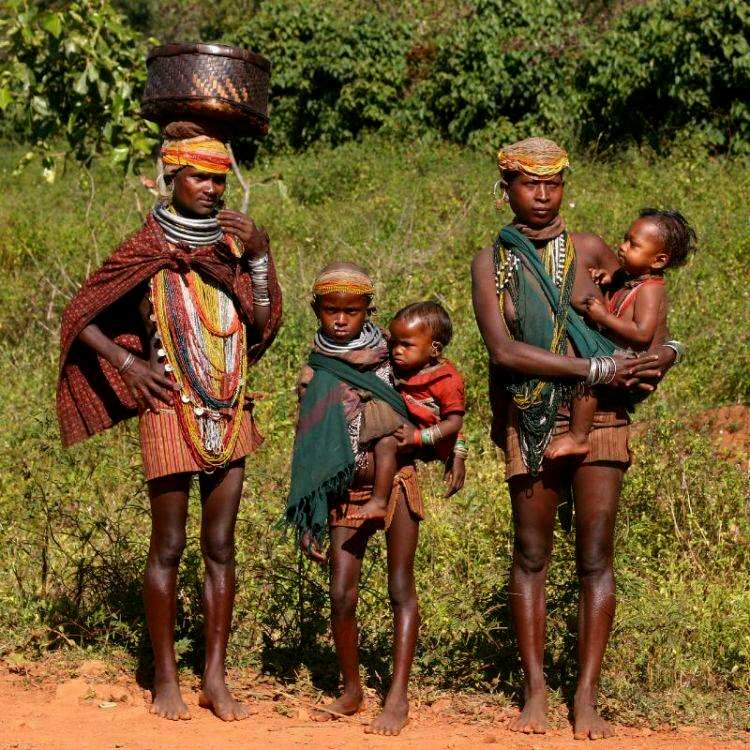
Indian Ethnicity: Tribal Groups

Figure 1.--The Bonda are an Indian tribal group which lives in the isolated hill regions of the Malkangiri district of Orissa. Their culture has changed little over the time. Although now sometimes you can see western style garments on men and children. Most Binda, however, continue to wear traditional clothing. The women wear metal neck-bands and bracelets and cover the breast only with beads necklaces. The photograph here shows women and children on the way to the weekly market that takes place in the village of Onukudelli.
|
|
India has hundreds of tribal groups that have special status under current Indian law. Counting them is in itself difficult as many tribal groups have related sub0groups. Nearly 70 million Indians belong to tribal groups. They vary considerably in size. Some have millions of members while others just a few thousand. Their life styles are extremely varied. As is their ethnicity, commonly varying from the two dominant groups, Indo-Aryans and Dravidians. The tribal groups in modern India are under constant pressure from wider Indian society. Tribal groups exist throughout India. Most are found in geographically isolated ares such as desert, hill, and forest regions or on islands. These were for the most part areas of low agricultural productivity that more technologically advances Indians were not particularly inteested in settling. In the case of islands, they were difficult to reach. There are, however, far fewer isolated areas of India than was once the case. Railroads and highways now crisscross the country. Thus virtually all of the tribes have considerable contact with wider Indian society with all of the allures of modern life. Many of the tribes are making a transition away from hunting and gathering. Here India's expanding population has encroached on traditional hunting grounds and wildlife populations. And sedentary agriculture is more productive. Productivity for most people is the only way of raising living standards. Because few tribal people have gone to school or progressded very far in school, there emplyment opportunities are limited. This means that for the most part they are limited to subsistence agriculture or low-status jobs as unskilled laborers. Their traditional religious commonly of ancient origins are decaying and they are gradually adopting some of the beliefs and practices of of India's main stream religions: Hinduism, Islam, Christianity, and Buddhism. Many of the tribal grouos are not well known and have not been well studied. One of the best known groups are the Santal of Orissa, Bihar, and West Bengal. This tribe includes over 4 million members.
Bonda
The Bonda are an Indian tribal group which lives in the isolated hill regions of the Malkangiri district of Orissa. Their colorful culture has changed little over the time. Although now sometimes you can see western style garments on men and children. Most Binda, however, continue to wear traditional clothing. The women wear metal neck-bands and bracelets and cover the breast only with beads necklaces. The photograph here shows women and children on the way to the weekly market that takes place in the village of Onukudelli.
The Lepcha people are also known as the Rongkup meaning in their language the children of God. Other names include the Rong, Mútuncí Róngkup Rumkup. They are one of the indigenous peoples of Sikkim and the easten Himilay in general. The Sikkim population numbers some 30,000-50,000 people. The total population may be as high as 80,000. Many Lepcha also live in western and southwestern Bhutan, Tibet, Darjeeling, the Mechi Zone of eastern Nepal, and in the hills of West Bengal. The Lepcha are composed of four main distinct communities: the Renjóngmú of Sikkim; the Támsángmú of Kalimpong, Kurseong, and Mirik; the ʔilámmú of Ilam District, Nepal; and the Promú of Samtse and Chukha in southwestern Bhutan. The origins of the Lepcha are not well established, but debated among anthropologists. There are indcatins that they variously originated in Myanmar, Tibet, or Mongolia. Lepcha legends firmly place them as indigenous to the Sikkim and surronding Himayan regions. Thy firmly believed that they originated is Nye Mayel Lyang maning essetially Sikkim. The Lepcha do not accept antropological evidence that suggest that they migrated into Sikkim. They speak a Tibeto-Burman language which may provide clues to origins and is commonly classifed as Himalayish. This leads to the most common anthropological thought that they emigrated directly from Tibet or from Eastern Mongolia south into the Himilayas. Some suggest wider origins, including Japan or Korea. There are also theories which postulate a more complex migration that began in southeast Tibet.
Santa
One of the best known groups are the Santal of Orissa, Bihar, and West Bengal. This tribe includes over 4 million members.
HBC

Navigate the Boys' Historical Clothing Web Site:
[Return to the Main Indian ethnicity page]
[Return to the Main Indian country page]
[Introduction]
[Activities]
[Biographies]
[Chronology]
[Clothing styles]
[Countries]
[Topics]
[Bibliographies]
[Contributions]
[FAQs]
[Glossaries]
[Images]
[Links]
[Registration]
[Tools]
[Boys' Clothing Home]
Created: 12:56 AM 6/18/2012
Last updated: 4:22 PM 1/7/2018



